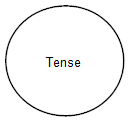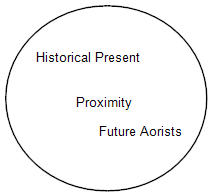I cause a bit of confusion over at the B-Greek list a couple weeks ago trying to explain Proximity, Tense and Temporal Reference.
My goal had been simply to show how similar the views were, but I only ended up making things worse. But I want to rectify that. I’ve constructed a few charts, which I hope will help.
In the first, we have a view that only has Tense represented as a small circle. This is how temporal reference was originally described. In the circle present verbs refer to the present, aorists and imperfects to the past and so forth.
But scholars quickly recognized that this was not enough. Some things, such as Historical Presence or Future referring Aorists, did not fit. This resulted in attempts maintain the system of Tense, while recognizing the exceptions to the use of the verb forms.
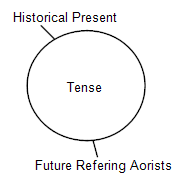 Now little lines coming out of our circle just isn’t that attractive too look at. So somebody (Porter) said, “Why don’t we make the circle bigger?”
Now little lines coming out of our circle just isn’t that attractive too look at. So somebody (Porter) said, “Why don’t we make the circle bigger?”
Now such anomalies such as the Historical Present and Future referring Aorists fit nicely within the circle. And because tense itself is quite often historically develops out of such a spacial system, what we said about tense also fits within the larger circle as well.
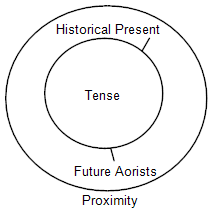 But since tense is a technical term for a system specifically expressing time, those who suggested this larger circle also suggested not using the word tense:
But since tense is a technical term for a system specifically expressing time, those who suggested this larger circle also suggested not using the word tense:
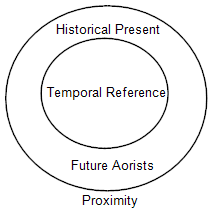 I write all of this less with an interest is subscribing specifically to one model. I’m more interested in showing how little difference there are between the two perspectives on time and the Greek verb.
I write all of this less with an interest is subscribing specifically to one model. I’m more interested in showing how little difference there are between the two perspectives on time and the Greek verb.
Both sides still have challenges. For one, as far as I know, there hasn’t been an explanation of future referring aorists in a tense system, [update] though Randal Buth has suggested that it easily can be.] Also for those who prefer a proximity system, if the “present” (a.k.a. the “imperfective proximate form”), is not time referring and thus fits the Historical Present usage better, exactly what about the verb form is it that makes it pragmatically marked, whether to mark discourse boundaries or prominence in what follows? (Levinsohn, 200-201) Is proximity enough to do this? I’m not so sure. I think Steve Runge’s comment on the B-Greek list this morning puts it well:
My immediate concern is the apparent attempt to treat the historical present as normative usage of the verb form.
If it is normative, how can it be a marked usage?
With both those said, its possible that someone has answered those questions some where. I definitely don’t claim to have read everything – just some – and if anyone wants to suggest reading. I’ll take it.
